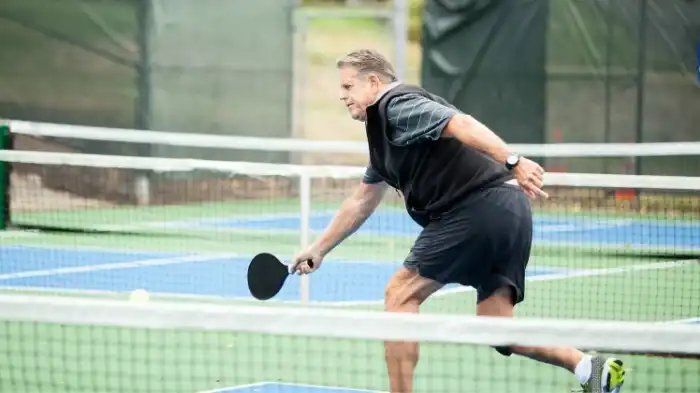Pickleball is a fast-growing paddle sport that blends elements of tennis, badminton, and table tennis. Whether you are a beginner or an experienced player, having a solid strategy is crucial to your success in singles matches. In this blog, we will discuss various Pickleball Singles Strategy that can help you improve your game and outwit your opponents.
Introduction: Pickleball Singles Strategy
Singles pickleball is played between two players on a court divided by a net. Pickleball Singles Strategy requires agility, quick reflexes, and effective shot placement. Unlike doubles, which involves teamwork and communication with a partner, singles relies solely on your individual skills and tactics.

Understanding the Court Positioning
Positioning yourself correctly on the court is essential in singles pickleball. For an aggressive playstyle, it’s recommended to take a position slightly behind the baseline to have a clear view of the court and be ready to react to your opponent’s shots. Staying too close to the net can leave you vulnerable to lobs or drop shots.
Serve and Return Strategy
The serve is a significant opportunity to gain an advantage. Start the serve by hitting low over the net and towards the middle of the service box, aiming to prevent your opponent from attacking the ball effectively. Varying your serve placement and spin can keep your opponent off balance.
When returning a serve, aim for deep and low shots to push your opponent back and limit their offensive options. The goal is to force them into a defensive position, allowing you to take control of the point.
Shot Selection and Placement
Pickleball singles requires a mix of offensive and defensive shots. Here are some essential shot strategies:
1. Groundstrokes:
Groundstrokes are shots hit off a bounce. Aim for deep shots to keep your opponent at the baseline, making it harder for them to attack. Alternating between cross-court and down-the-line shots can help you control the pace of the game and create openings for winners.
2. Volleys:
Volleys are shots hit before the ball bounces. Try to hit volleys deep to keep your opponent on their toes, preventing them from easily approaching the net. Angle your volleys to exploit open areas of the court and force your opponent into difficult positions.
3. Dinks:
Dinks are soft shots hit from the non-volley zone near the net. Use dinks strategically to get your opponent out of position. Aim for their weaker side or exploit any openings created by their positioning. Dinks can set up an opportunity for a well-placed drop shot or a hard drive.
4. Drop Shots:
Drop shots are shots hit with enough backspin to make the ball fall close to the net. Use drop shots to catch your opponent off guard when they are out of position or to force them to move quickly towards the net, making it difficult for them to return the ball effectively.
5. Lobs:
Lobs are high shots hit over your opponent’s head. Use lobs strategically to push your opponent back and create opportunities to move them around the court. Well-executed lobs can force your opponent into defensive positions and open up the court for winners.

Defensive Tactics
Defensive play is crucial in singles pickleball. When your opponent is on the offensive, try to stay calm and focused. Stay balanced and be prepared to move quickly. Use deep shots to buy time and regain control of the rally.
Conclusion
Pickleball singles strategy involves a combination of various shots, proper court positioning, and smart decision making. The key is to observe your opponent’s strengths and weaknesses and adjust your strategies accordingly.
Remember to constantly practice and refine your skills to become a formidable player. As you gain experience, you will develop your unique style and tactics that work best for you. So get out on the court, apply these strategies, and enjoy the thrilling game of pickleball!
Frequently Asked Questions
A1: Yes, while there are some similarities, singles strategy in pickleball is unique and requires a different approach. It focuses more on individual court coverage, shot selection, and adapting to the opponent’s playing style.
A2: Footwork is crucial in singles pickleball as it allows you to reach the ball quickly and maintain balance. To improve footwork, practice agility drills, work on constant movement, and ensure quick recovery after each shot.
A3: To maintain control in singles pickleball, it is essential to control the pace of the game by using soft shots, deep returns, and strategic drop shots. By forcing your opponent to move around the court and making them defensive, you can keep control of the game.
A4: The style of play in singles pickleball should be adaptable. Depending on your opponent’s strengths and weaknesses, you may need to play aggressively by taking charge of the points or play defensively by focusing on consistent shots, minimizing unforced errors, and waiting for the right opportunity to attack.
A5: To exploit your opponent’s weaknesses in singles pickleball, pay attention to their playing style, footwork, and shot selection. Adjust your strategy accordingly, targeting their weaker shots, exploiting their movement limitations, and forcing them out of their comfort zone with well-placed shots and smart shot selections.

